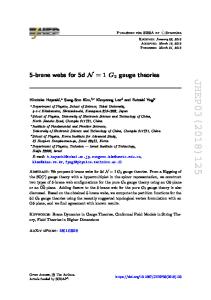N $$ \mathcal{N} $$ = 2 Conformal SYM theories at large N $$ \mathcal{N} $$
- PDF / 1,106,456 Bytes
- 59 Pages / 595.276 x 841.89 pts (A4) Page_size
- 61 Downloads / 423 Views
Springer
Received: July 11, 2020 Accepted: August 17, 2020 Published: September 17, 2020
N = 2 Conformal SYM theories at large N
a
Universit` a del Salento, Dipartimento di Matematica e Fisica “Ennio De Giorgi”, and I.N.F.N. - sezione di Lecce, Via Arnesano, I-73100 Lecce, Italy b Universit` a di Torino, Dipartimento di Fisica, and I.N.F.N. - sezione di Torino, Via P. Giuria 1, I-10125 Torino, Italy c Universit` a del Piemonte Orientale, Dipartimento di Scienze e Innovazione Tecnologica, Viale T. Michel 11, I-15121 Alessandria, Italy d I.N.F.N. - sezione di Torino, Via P. Giuria 1, I-10125 Torino, Italy
E-mail: [email protected], [email protected], [email protected], [email protected], [email protected] Abstract: We consider a class of N = 2 conformal SU(N ) SYM theories in four dimensions with matter in the fundamental, two-index symmetric and anti-symmetric representations, and study the corresponding matrix model provided by localization on a sphere S 4 , which also encodes information on flat-space observables involving chiral operators and circular BPS Wilson loops. We review and improve known techniques for studying the matrix model in the large-N limit, deriving explicit expressions in perturbation theory for these observables. We exploit both recursive methods in the so-called full Lie algebra approach and the more standard Cartan sub-algebra approach based on the eigenvalue distribution. The sub-class of conformal theories for which the number of fundamental hypermultiplets does not scale with N differs in the planar limit from the N = 4 SYM theory only in observables involving chiral operators of odd dimension. In this case we are able to derive compact expressions which allow to push the small ’t Hooft coupling expansion to very high orders. We argue that the perturbative series have a finite radius of convergence and extrapolate them numerically to intermediate couplings. This is preliminary to an analytic investigation of the strong coupling behavior, which would be very interesting given that for such theories holographic duals have been proposed. Keywords: 1/N Expansion, Extended Supersymmetry, Supersymmetric Gauge Theory ArXiv ePrint: 2007.02840
c The Authors. Open Access, Article funded by SCOAP3 .
https://doi.org/10.1007/JHEP09(2020)116
JHEP09(2020)116
M. Beccaria,a M. Bill` o,b F. Galvagno,b A. Hasana and A. Lerdac,d
Contents 1 Introduction
1
2 N = 2 CFT theories 2.1 The ABCDE theories 2.2 Matrix model from localization 2.3 The full Lie algebra approach
4 5 5 7 11 11 13 15
4 Large-N limit from the eigenvalue distribution 4.1 The large-N universal integral equation 4.2 Single-trace mixing at large N and two-point functions 4.2.1 The N = 4 SYM theory 4.2.2 The ABCDE theories 4.3 One-point functions in presence of the Wilson loop 4.3.1 The N = 4 SYM theory 4.3.2 The ABCDE theories 4.4 Asymptotic correlators of operators with large dimension
20 21 22 23 25 28 29 29 29
5 The full Lie algebra approach for the ν = 0 theories
30
6 The eigenvalue distribution approach
Data Loading...











